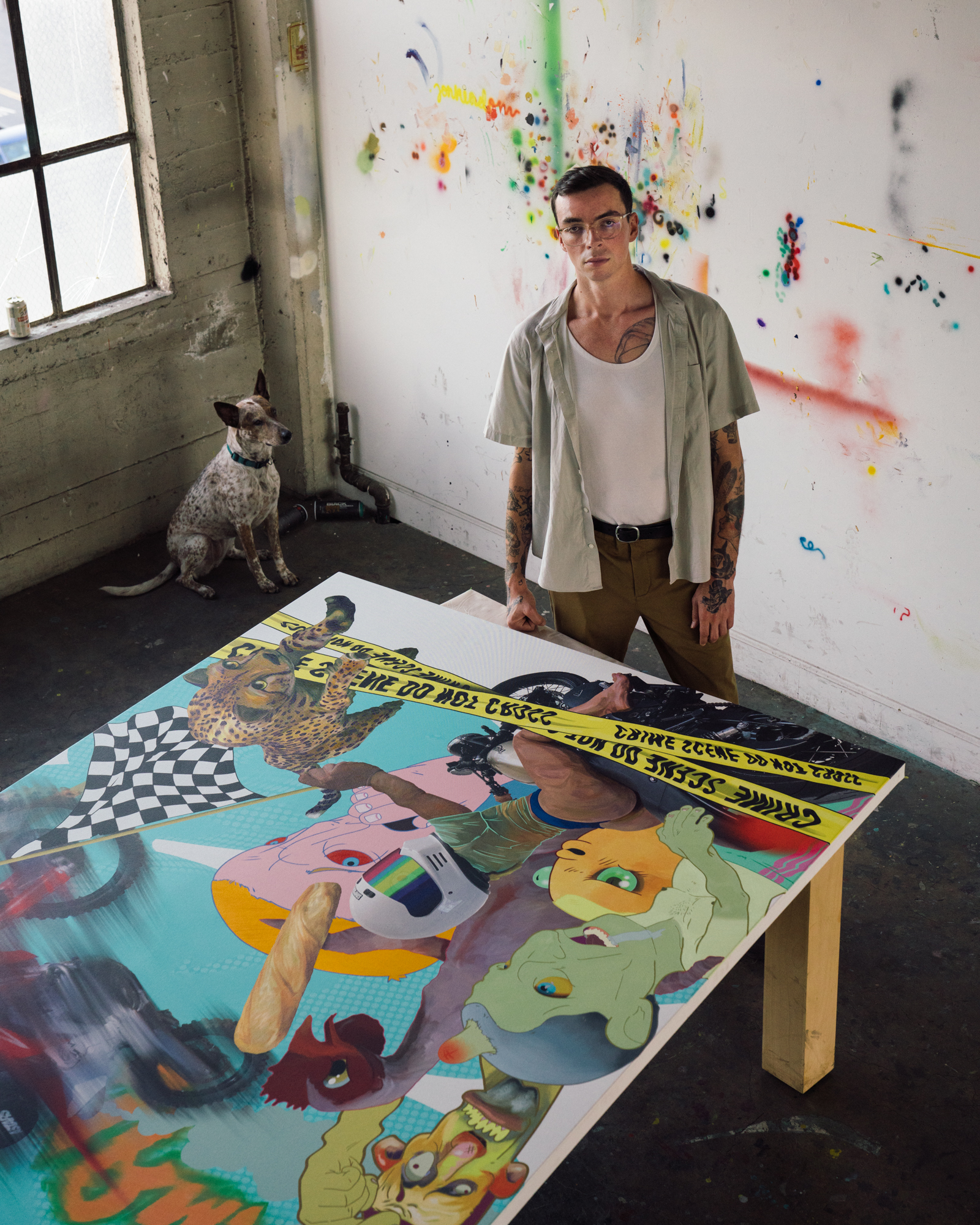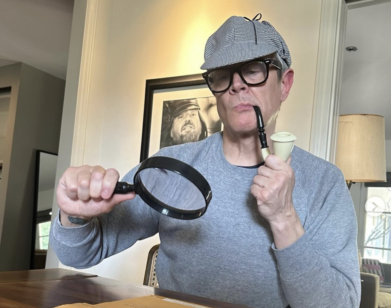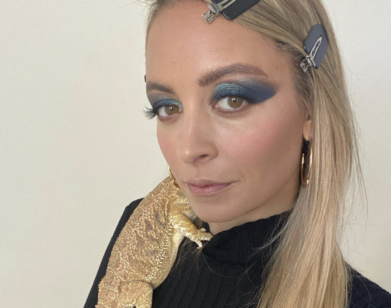The Deranged Whimsy of Artist Canyon Castator
The L.A.-based painter Canyon Castator uses a metaphor to frame his artistic practice: “If the gallery is a dinner party,” he says, he’ll be there on time and ready to start all the awkward conversations. The 30-year-old artist’s allegories for climate change, alt-right media, and American consumption come steeped in sardonic humor and alluring color. Filling his paintings with a bizarre assortment of characters that pull from TV cartoons, arcade games, and the streets of the American youth, Castator playfully serves incisive social commentary while inviting viewers to dig in.
Despite the cynicism of his work, Castator resists the cliché of the miserable, self-isolating artist. Since setting up a studio in downtown L.A. five years ago, he has converted several floors in the building into working spaces for fellow artists, offering a readymade community to young practitioners navigating the city’s sprawling landscape and disparate creative scenes. Recently, he’s partnered with Carl Kostyál Gallery and the arts organization ILYSM to establish a month-long artist residency in one of his open studios.
With works now on view in two exhibitions that reflect on the socio-political impact of COVID-19—“We Used to Gather” at Library Street Collective in Detroit and “Riders of the Red Horse” at The Pit in L.A.—Castator appears to be hitting his stride within the dystopian climate of our current moment. We called up Castator at his studio to talk about art, the apocalypse, and opening up uncomfortable conversations.
———
ELLA HUZENIS: So many of your works depict these crowded arrangements of human and animal characters. How do you conceive of these scenes? And, has your perception of these kinds of gatherings changed at all in this era of “social distancing”?
CANYON CASTATOR: I guess the work to me is constructed a little differently. A lot of the characters—yes, they are people or cartoons or animals and they’re closely compacted—but they’re all kinds of symbolic icons for this relationship of ideas, jumping from one to another. You know, one character might represent this idea to me, another character represents another thing. So I’ve kind of dehumanized them in a way, so that they can, in my mind, represent these themes and play off one another. In the early work, I was making paintings that had my friends and using old photographs but now, really, these characters are just stand-ins for ideas. And sometimes, it’s a clear concept, a clear idea, and other times, one thing contradicts another.
HUZENIS: Similarly, in the past, you’ve painted figures without backgrounds as well.
CASTATOR: That was really about de-contextualizing images from their environment and throwing them into a blender and kind of making them stand for themselves. If you have an entire scene, a deer looks like it belongs in a picture with nature in the background—it’s a setting, it just feels like it belongs—but then, if you remove that and you pair it up against something else and neither element really belongs or has an environment to react to, then those images are forced to react to one another, and I think you get more out of each one of those images that way. For a while, I was just completely de-contextualizing things in the space. It also allowed me to operate without gravity, or the rules that are inherently dictated by creating a space.
I loved the way that those paintings looked, but if you have the brightest color that you can possibly imagine, straight out of the tube onto an all-white canvas, that white is still going to eat it up. It makes it so hard to play colors off one another if there’s always this very, very overpowering white background that they have to sit in. So I think on a conceptual level, I really liked the thinking behind it, but I’ve been adding backgrounds and colors lately. I can sacrifice the de-contextualization of the image.
HUZENIS: Tell me about your most recent set of works, “Real Tap Water,” “Karaoke Bar,” and “Sunset”. Were all these made in quarantine?
CASTATOR: “Real Tap Water” was supposed to be shown at the Dallas Art Fair, which was canceled due to the pandemic. I kind of knew that that was going to happen while I was making it and therein didn’t finish it in time for the deadline because the deadline meant nothing. I was afforded more breathing time because of that.
The other two paintings were both made during quarantine for Library Street Collective in Detroit. Both will be included in a catalogue and an exhibition called “We Used to Gather.” I’d been speaking with them about what was going on and the kind of work I was making and things that I was missing, and they were telling me about the whole concept behind the show. I love, love, love—to an embarrassing degree—karaoke.
HUZENIS: Do you have a go-to karaoke song?
CASTATOR: Yeah, there’s an Eminem song that I do, “Without Me.” My friends still, to this day, give me shit about it because it’s embarrassing how well I can do this one Eminem song. But I grew up in a trailer in the middle of nowhere—he was a success story.
HUZENIS: The scenes in these works all share a kind of apocalyptic atmosphere. What is it about the apocalypse that interests you?
CASTATOR: Well, I think I’ve kind of created this practice for myself where I can touch on incredibly serious and morbid or repulsive themes because I’m balancing that out with humor, satire, these cartoon-like elements. I try to find a way to make these themes palatable because I think it’s difficult and unsettling for certain people. If a gallery is a dinner party, and somebody brings something that people don’t want to talk about in a very direct manner, it’s awkward silence and then, “oh we don’t talk about that in this household.” But if you do it in this kind of sardonic, playful approach, you can trick people into talking or thinking about things that they would typically find uncomfortable, which I think is a major part of my practice that I enjoy.
I had this show in New York at Postmasters Gallery and the concept behind the show was the fragile mind of someone who becomes attracted to conspiracy theories and throws themself into the conspiracy theory culture that’s available on the internet. It’s obviously all tongue-in-cheek, but I’m able to take the temperature in real time of some of the ugliest sides of American history. Finding these back-door ways to open up uncomfortable conversations is really something I look for in the work.
HUZENIS: Tell me about your artist community in L.A. and the spaces you’ve been converting into artist studios.
CASTATOR: When I moved here, I didn’t have the intention to move to Los Angeles. I came out for a two-week apartment switch with a friend. He was living in L.A., I was living in New York, and we just switched. By the time the two weeks was up, both of us had decided that we wanted to move, so we just both stayed. It was the most effortless, unplanned, and breathless effort to move to Los Angeles.
I had a room in a very large loft building with other people downtown, and I spent about a month-and-a-half just walking into buildings, looking for a studio that was close enough that I could commute on foot daily. I walked into dozens of these old industrial buildings, asking if they were open to renting to an artist. Then I just happened to be walking past this place one day and saw them drop a “For Lease” sign on the window, and I went up.
My dad is also an artist and lives in Los Angeles—he moved here six months before I did, coincidentally. He was also looking for a studio, and we found this beautiful, open space in this building. Eventually we developed this relationship with the landlord where he got over his hesitation about renting to artists. I think he still refers to it as “this artsy-fartsy stuff that he doesn’t understand,” but we pay rent on time, so he loves that.
As businesses have moved out of the building, we’ve just jumped on the lease for each floor and have taken them over and built out artist spaces. Now it’s nothing but artists. It’s amazing. It’s completely transformed the feeling of the building.
HUZENIS: How do you determine who rents?
CASTATOR: Other artists have recommended friends. That’s how the majority of the spaces have been filled. But between myself and my father, we’ve kind of just wanted serious artists only. No vanity-project-bullshit. No DJs.
My friends outside of that little microcosm aren’t artists. I spend a lot of time with friends I grew up with in Colorado that ended up here or people that work and operate and exist in completely different worlds.
HUZENIS: What was it like growing up in a college town like Boulder?
CASTATOR: Well, I was born in Texas and lived with my mom until I was 10, out in the middle of the country, outside of Austin. Then I moved to go live with my dad at like 10 or 11. It was a completely different experience because we lived in the center of Boulder—all of a sudden, I lived in a city. Well, maybe Boulder’s a city, maybe it’s a town, I’m not sure. It’s a big little place.
Boulder was a weird place to grow up because it’s a bubble. I think in the time that I lived there the school was voted “number one party college in America.” I’m six-foot-three and have been since I was a freshman in high school, so it was amazing because if I was walking home and walked past some college party, I would just walk in and start bullshitting about how bad whatever program was that I was in and drinking. I was skateboarding a lot at the time, so all of my friends were older than me from the skate park, and they would invite me. I never had an eyebrow raised at the fact that I was like 15. It was a very quintessential college experience, without ever having to go to class.
HUZENIS: Were you a rebellious kid?
CASTATOR: I was just kind of a prick. I went to an alternative high school that I was able to not attend all the time because I was traveling for skateboarding. I rode for a small company and we would make videos and I would go on filming trips and compete in and out of state. It’s a great way to grow up because the skate park is this amazing melting pot of different people and freaks and people that have grown up but still remain interested in this thing from their childhood. Just across the board, I was exposed to quite a bit.
HUZENIS: Both of your parents are artists, but aside from their influence, you’re mostly self-taught.
CASTATOR: I didn’t go to art school. I started painting around the end of high school and I moved to New York. No one in my high school in Boulder was ever like, “Oh yeah, you should apply to Cooper Union, it’s free if you get in.” I would have conversations with people at these institutions, and they’d be like, “Well you might think you might want to be an X character now but we’ll find some way that you can apply your talents to X, Y and Z.” I was just so turned off.
So I moved to New York for exposure and to be around this thing that I didn’t know anything about, but obviously realized was important. And, I guess, to cultivate taste, which I had none of before I moved there. I started working at galleries as an art handler and [with the recommendation of a close mentor, New Museum Deputy Director Karen Wong] the New Museum hired me on their installation staff. Then, by a weird chain of events, through Karen Wong, I was introduced to the artist Tal R, who invited me to be a guest student of his during his last semesters at the Kunstakademie in Düsseldorf.

“Horses in Mid Stream,” 2020. Oil, uv cured ink, spray on canvas. Courtesy of Carl Kostyál Gallery.
As far as institutional education, that’s the most that I’ve got under my belt, and it was incredibly beneficial. It was 100 euro a semester as a registration fee. That’s it. And there were no real classes. It was just studio all the time. That has completely informed the way that I built up the studios here in the building. Very few of them have four walls. They’re mostly just divided spaces with this kind of open-air, community feeling to them.
HUZENIS: What was the experience of working as an art handler at the New Museum like?
CASTATOR: My life opened up quite a bit because you do these very intensive installations and de-installations that were maybe two or three weeks worth of work where you’d rack up a lot of hours and overtime. And then I had a month, basically, to be in studio. That was the best moment for me in New York—work-life balance.
I helped install the Chris Ofili retrospective, and just to be that close to those paintings and see them in person for the first time was amazing. I somehow wound up at a hotpot dinner with Chris and Karen Wong. He’s hands-down the coolest artist I’ve ever met, maybe the coolest person I’ve ever met. The guy literally just breathes in air, exhales cool. One of the coolest experiences from my last exhibition in New York was when [New Museum director] Lisa Phillips came and did a walkthrough. It was a very surreal experience because I used to get checks with her name on the back.
HUZENIS: You mentioned that you still share your studio with your father. Tell me about your working dynamic.
CASTATOR: We’re very similar, but we don’t keep kind of the same hours. The space is divided; he has his zone and I have my zone. I feel like a lot of people couldn’t spend that amount of time around their parents, but he’s probably the most informed person I could talk to about my work, as he’s seen it develop over the course of my entire life.
HUZENIS: What’s the most valuable lesson you’ve learned from him?
CASTATOR: I think the greatest thing he’s instilled in me is how to remain excited about your work, to celebrate each tiny victory. Not everything is going to be amazing, so when you do have these moments where you feel like you’ve had some level of success, you have to bask in them and celebrate them. He’s been an artist my entire life, and he’s remained excited about his practice and eager to make things. That’s just a really good way to live. Ultimately, being an artist is very much about living a life worth reflecting into objects or images. I think it’s important to be happy. I don’t really get off on the whole miserable, “brooding” thing. That’s another reason why I like being in LA. Everyone’s happy and fucking tanned all the time. The sun is shining every single day. How are you going to be this suicidal masochist if you live here?











